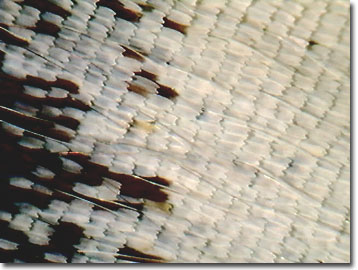Butterfly Wing Scale Digital Image Gallery
Eastern Tiger Swallowtail Butterfly
Easily recognized by its large bright yellow wings with black stripes, the eastern tiger swallowtail is one of the most spectacular and boldly colored butterflies of North America. Adult males of the species have the ability to recognize areas of high moisture and minerals from the air based on the sodium ion concentration of a site, and visit such places to gain additional nutrients.

Common throughout the eastern United States, eastern tiger swallowtail butterflies range from the Canadian border in the Great Lakes region, south into northern Mexico, and west to the foot of the Rockies. The species scientifically known as Papilio glaucus is well adapted to living in urban and suburban areas along parks and greenways, but river valleys, forest edges, and deciduous broadleaf woods are preferred. Adult eastern tiger swallowtails feed on flower nectar from a wide variety of plants, but favor wild cherry or lilac blooms. The butterflies are especially fond of nectaring on aromatic Oriental lilies when they are available and tend to avoid pine plantations.
The female eastern tiger swallowtail butterfly may exhibit one of two different facades, but adult males can easily recognize either. Females may assume either a yellow form similar to the male or a black, darkly striped morph. The black form is believed to be an edible mimic of the unpalatable pipevine swallowtail butterfly. Yet, no matter which morph occurs, female members of the species feature iridescent blue scales and an orange marginal spot on their hind wings. Since eastern tiger swallowtails demonstrate an unusual sensitivity to light, the coloring of the females helps ensure species recognition. Males avoid white butterflies, which reflect ultraviolet light, but are drawn to butterflies that absorb ultraviolet wavelengths, including the two female eastern tiger swallowtail color morphs.
Larval eastern tiger swallowtails rest on spun silken mats in the shelter of curled leaves during the day and feed on host leaves at night. Unlike many host specific butterflies, the relatively large, robust green caterpillars may be found chewing leaves on a wide variety of host plants, including wild cherry, basswood, birch, ash, cottonwood, mountain ash, and willow. The caterpillars exhibit a pair of prominent thoracic false eyespots, which are yellow with a blue center. The markings may persuade a potential predator that the larval swallowtail is much more formidable than it truly is or fool an attacker into striking its back instead of the vital head region.
Eastern Tiger Swallowtail Butterfly Images in Reflected Light
Wing Scale Array - The creamy colored wing scales in this image were captured under a higher level of magnification than those presented above. The delicate structures appear thin and papery.
Contributing Authors
Cynthia D. Kelly, Shannon H. Neaves, Laurence D. Zuckerman, and Michael W. Davidson - National High Magnetic Field Laboratory, 1800 East Paul Dirac Dr., The Florida State University, Tallahassee, Florida, 32310.
BACK TO THE BUTTERFLY WING SCALE IMAGE GALLERY
BACK TO THE DIGITAL IMAGE GALLERIES
Questions or comments? Send us an email.
© 1995-2025 by Michael W. Davidson and The Florida State University. All Rights Reserved. No images, graphics, software, scripts, or applets may be reproduced or used in any manner without permission from the copyright holders. Use of this website means you agree to all of the Legal Terms and Conditions set forth by the owners.
This website is maintained by our
Graphics & Web Programming Team
in collaboration with Optical Microscopy at the
National High Magnetic Field Laboratory.
Last Modification Friday, Nov 13, 2015 at 01:19 PM
Access Count Since January 21, 2003: 27026
Visit the website of our partner in introductory microscopy education:
|
|
